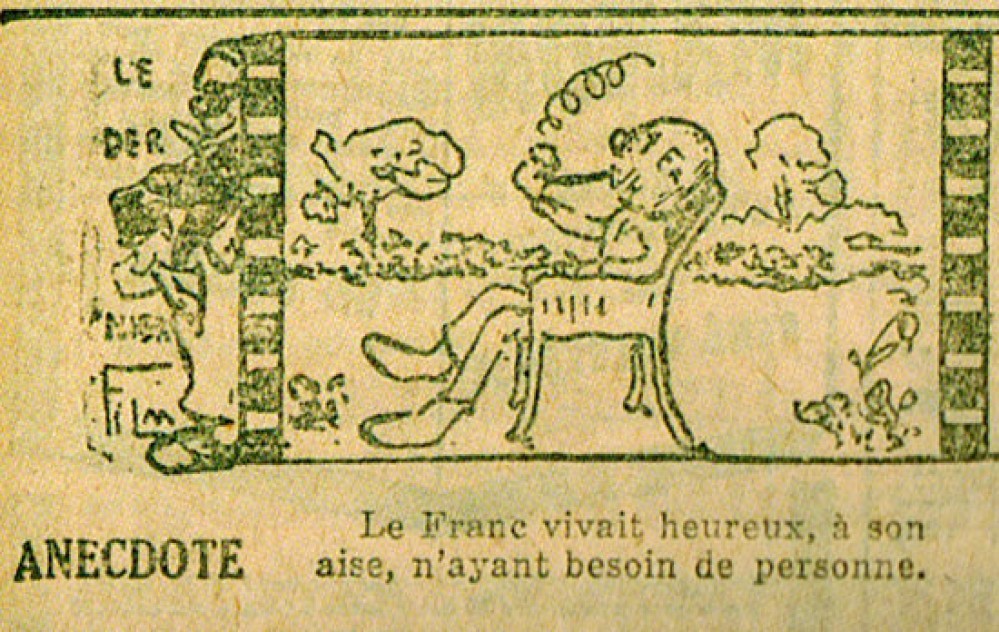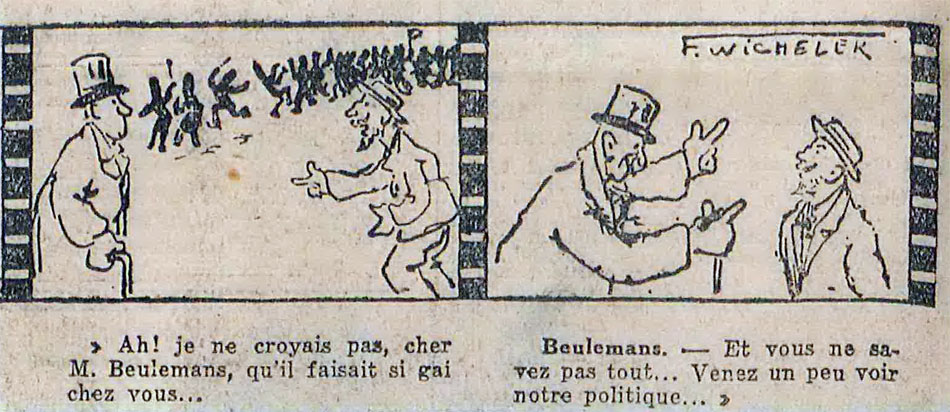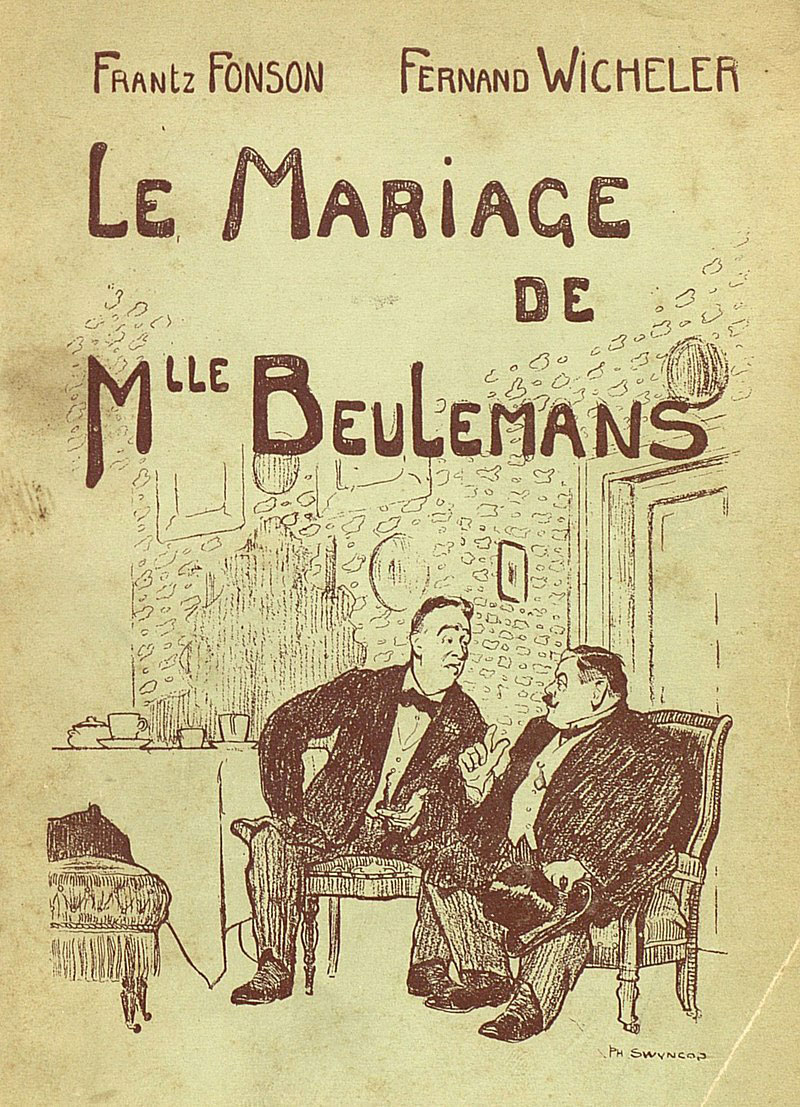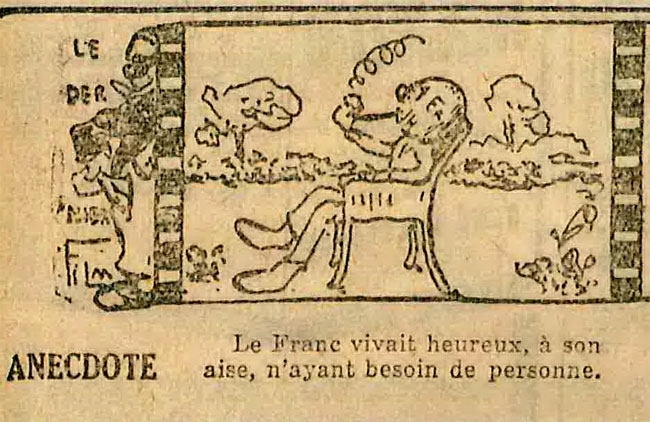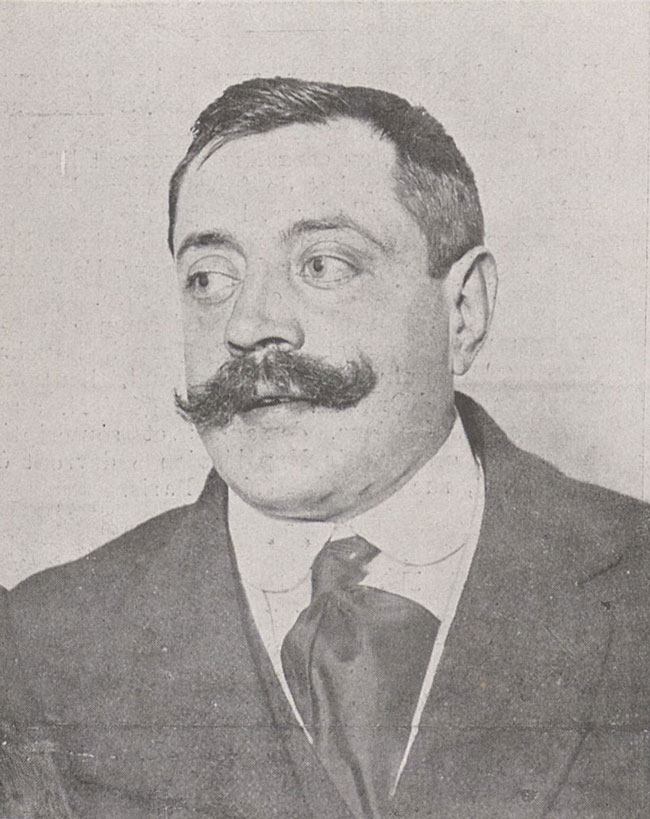'Le Dernier Film' (Le Soir, 15 June 1925) featuring a cameo from Wicheler's theatrical character Mr. Beulemans.
Fernand Wicheler was an early 20th-century Belgian playwright, screenwriter, actor, journalist and singer. He is best-known for his farcical plays, performed in Brussels dialect, of which 'Le Mariage de Mademoiselle Beulemans' (1910), co-written with Frantz Fonson, became a huge success, even beyond the Belgian borders. A pioneer of Belgian newspaper comics, Wicheler was additionally notable for writing and drawing the satirical gag comic 'Le Dernier Film' (1921-1926) in the newspaper Le Soir. He is also the first known Belgian comic artist to occasionally use speech balloons.
Life and theatrical career
Fernand Wicheler was born in 1874 in Brussels. In 1910, he became head of the local Olympia Theater. Together with Frantz Fanon, head of the Théâtre des Galeries, he wrote the farcical play 'Le Mariage de Mademoiselle Beulemans' ("The Marriage of Mrs. Beulemans"), which premiered on 18 March 1910. The folksy play, performed in a juicy Brussels dialect with lots of silly humor, ridiculed the local bourgeoisie and was an instant success. On 7 June of that same year, the show also premiered in Paris, where it acquired a similar triumph. Well into the 21st century, 'Le Mariage de Mademoiselle Beulemans' has continued to be frequently restaged. On 18 October 1912, Fonson and Wicheler adapted their play into an operetta, with music by Arthur Van Oost. The play has been adapted to film three times, first as a silent movie by Julien Duvivier in 1927, and then again by Jean Choux (1932) and André Cerf (1950). The Walloon public TV channel RTBF also adapted the play for television multiple times. Acclaimed French film director Marcel Pagnol cited 'Le Mariage de Mademoiselle Beulemans' as a strong inspiration for his famous plays 'Marius' (1929), 'Fanny' (1931) and the film sequel 'César' (1936).
Poster for 'Le Marriage de Mlle. Beulemans', with artwork by Philippe Swynen.
The play 'Le Mariage de Mademoiselle Beulemans' even spawned the eponym "verbeulemansing" ("beulemanisation"), coined in 1917 by the Belgian poet Virginie Loveling. It refers to words and expressions of the common people being changed to sound more posh, even though the pronunciation still betrays the speakers' humble origins. In Beulemans' original play, the characters also mix Dutch and French together, as is common in certain regions of Brussels. Some of their French expressions are literal and thus incorrect translations of Dutch sayings. One such example, "Je suis chemin" (meaning "I am going", but literally: "I am a road") was later used by Marc Sleen's French-language Belgian character Meneer Pheip in his signature newspaper comic 'Nero'.
Two other significant plays by Fernand Wicheler were 'La Demoiselle de Magazin' (1913), also co-written with Fonson, and Loïc de Gouriadec's 'Marie-Rose' (1937), adapted to film by Gaston Schoukens as 'Mon Père et Mon Papa' (1937). Fernand Wicheler was married to Gilberte Legrand, a stage actress who played most of the female roles in his plays. He also wrote the scripts for several nowadays forgotten Belgian comedy films, namely 'Ce Que Femme Veut' (1921), 'Gigi ou La Folle Poupée' (1922), 'L'Ermite Effroyable' (1922), 'La Cure de l'Abbé Javel' (1922), 'Le Coup de Gilberte' (1922), 'La Maison dans la Dune' (1925) and 'La Parole est à Monsieur Beulemans' (1932). Fernand Wicheler passed away in 1935.
'Le Dernier Film' (Le Soir, 4 February 1924). The Belgian monetary unit is anthropomorphized.
Le Dernier Film
At age 47, Wicheler created the comic strip 'Le Dernier Film' ("The Latest Film"), serialized in the newspaper Le Soir between 18 July 1921 and 1 May 1926. The comic is presented in the style of a film reel, with the panels resembling vignettes with double perforated strips in black with little white dots. To keep in line with this format, Wicheler deliberately kept his artwork minimalistic, with characters usually talking against a white void. Rather than a standard three-to-four panel format nowadays associated with gag strips, 'Le Dernier Film' used seven panels per episode.
Wicheler's 'Le Dernier Film' is historically significant as the earliest known originally Belgian newspaper comic. Previous Belgian comic pioneers, such as Richard de Querelles, Émile Berchmans, Félicien Rops, Georges Ista, Victor T'Sas (Vias), Auguste Donnay, Henri Cassiers and Willem Seghers, also created comic-like picture stories, but these appeared in weekly magazines instead of newspapers. Even so, 'Le Dernier Film' was published on a weekly basis. Also, Le Soir had no permanent day on which new episodes appeared, making it complicated to track down all the episodes. While 'Le Dernier Film' was serialized on a regular basis, the feature had no real story or recurring characters, except for Mr. Beulemans from Wicheler's play, who sometimes had a guest role. Each episode is self-contained, with characters commenting on whatever was in the news that day. Certain jokes poke fun at Flemish nationalists, Belgian politicians, Communists, suffragettes and Germans. Specific celebrities with cameo appearances are Belgian Prime Minister George Theunis, Nobel Peace Prize laureate Henri La Fontaine, Flemish activist (and future Prime Minister) Camille Huysmans and the head of the Belgian Communist Party Joseph Jacquemotte. This satirical gimmick of including current affairs in a comic was preceded by other Belgian comic pioneers, namely in Richard de Querelles' 'Déluge à Bruxelles' (1843) and Félicien Rops' 'M. Coremans Au Tir National' (1861).
'Le Dernier Film' episodes from Le Soir of 7 November 1921 and 12 July 1923. In the first comic, two men discuss a "horrible" crime where various body parts were scattered in several different provinces. When the other asks who the culprit was, he is told that they'll be candidates for the next elections, because the victim wasn't important: "His name was 'Belgium'." The second comic, in which a father in stereotypical Soviet/Russian costume teaches his infant son on how to be dishonest, features examples of speech balloons.
'Le Dernier Film' follows a text comic format, with text captions underneath the images. However, in some episodes, like the installments printed on 7 August 1922 and 12 July 1923, characters use speech balloons, which at the time were still a rarity in Belgium and other European countries. For the first full-blown Belgian balloon comic, readers had to wait until 1929, when Hergé serialized his 'The Adventures of Tintin' in Le Petit Vingtième. Some gags of 'Le Dernier Film' are quite surreal. In one episode, printed on 4 February 1924, the Belgian franc is anthropomorphized as someone exploited by a pickelhaube helmet-wearing German mark, the American dollar and the British pound.
It has not been recorded why and how Wicheler suddenly ended up making a newspaper comic for Le Soir. As comic historian Pascal Lefèvre analyzed in a 2012 article in Brabant Strip Magazine, the artwork sometimes makes a sloppy impression, with rudimentary drawn characters and dialogue printed too small to be properly read. This observation leads to the impression that Wicheler possibly had little graphic experience and never made another comic again. On the other hand, 'Le Dernier Film' did run for almost five years, albeit on an irregular basis. This would imply that his editors and readers enjoyed it well enough.
'Le Dernier Film' (Le Soir, 24 November 1924). The children wonder why holiday character St. Nicolas (Sinterklaas) hasn't left them a gift and blame Prime Minister George Theunis.
Legacy and influence
Despite his important role in Belgian comic history, Fernand Wicheler faded away in obscurity for many decades. Although Le Soir had a large circulation, 'Le Dernier Film' had little impact on the development of Belgian comics. It seems likely that its irregular appearances and lack of serialized story failed to spark other cartoonists' imagination or really build up a devoted fanbase. Since the comedy was topical, the gags appealed more to adult readers than children. While in the following decades, Le Soir published more locally produced newspaper strips, the newspaper comic phenomenon never enjoyed the same popularity in Walloon papers as compared to Flemish papers. Especially after World War II, the comic production in Wallonia was almost completely absorbed by weekly children's magazines, spearheaded by Spirou and Tintin.
It wasn't until comic historian Pascal Lefèvre researched the origins of Belgian comics for his book 'Forging A New Medium: The Comic Strip in the 19th Century' (co-author Charles Dierick, VUB Press, 1998) that Wicheler's pioneering role was rediscovered. Lefèvre devoted an entire article to Wicheler and 'Le Dernier Film' in issue #189 (25 March 2012) of the comic news magazine Brabant Strip Magazine.
Fernand Wicheler in 1910 (Photo by Ernesto Brod).


